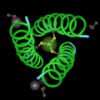You've probably heard about enterprising researchers attaching cameras to dolphins, dogs, and other animals, in order to learn how things look from the critter-point of view. Now, some enterprising lab rats have added a new twist to this technique.
It's lab cam!
From Attila Csordas , we have a report about researchers documenting their work through film in an unusual way. They put on a funky-looking hat with a digital camera attached and film their hands doing the experiments. There's even a short movie made by John Cumbers from OpenWetWare, on preparing Drosophila embryo chromatin for use in microarrays.
At last, we have the technology to go beyond our written notes and solve some of those mysterious technique questions about why some people couldn't isolate DNA even if they were given a tube of salmon sperm DNA as starting material.
I don't know how quickly this will catch on, but it's a nice start.
11/5/2006 Correction: the movie maker was John Cumbers and not Sri Kosuri. Thanks Attila!
technorati tags: laboratory, things that go wrong in the lab, video

The 3 parts of the Drosophila CHiP video can be seen here:
http://pimm.wordpress.com/2006/10/19/video/
I'm not so enthusiastic about this development. Experiments are based on theories that should give an account on the determining factors of them, give predictions for further expriments, etc. If an experiment can't be reproduced by this account, then the experiment's success was based on hidden factors, i.e. either the underlying theory was partial, or the experimental setup was wrong. Faithful photocopies of experimental setup mean faithful photocopies of hidden factors and thus will approve partial theories or wrong experiments. I would be more conservative on this issue: if an experiment could not be reproduced by it's advertised settings, then either the experiment, or the underlying theory was in trouble, and it is better to know that, than reproducing it without thinking.
Sorry incze, but in the real world, biology experiments often do fail, and often for reasons that are unapparent to the person doing them. Some people spend more time figuring out why things are going wrong than analyzing actual data.
We try to trouble-shoot by using as many positive and negative control samples as possible, but it can be hard to catch everything.
I remember a short period, when I was in graduate school, when everyone in a certain department, was having problems with their experiments. It turned out that the reason was a malfunctioning filter on the apparatus they used for making distilled water. Since all their solutions were made with distilled water, all of their experiments failed.
2 corrections: the movie maker was not Sri Kosuri but John Cumbers, and not OpentWetWear, but OpenWetWare.
http://openwetware.org/wiki/John_Cumbers
http://pimm.wordpress.com/2006/10/19/video/
Cheers, Attila.